Diffuse alveolar damage - Study guides, Class notes & Summaries
Looking for the best study guides, study notes and summaries about Diffuse alveolar damage? On this page you'll find 661 study documents about Diffuse alveolar damage.
Page 2 out of 661 results
Sort by
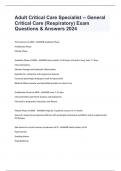
-
Adult Critical Care Specialist -- General Critical Care (Respiratory) Exam Questions & Answers 2024
- Exam (elaborations) • 8 pages • 2024
-
- $8.49
- + learn more
Adult Critical Care Specialist -- General Critical Care (Respiratory) Exam Questions & Answers 2024 Three phases of ARDS - ANSWER-Exudative Phase Proliferative Phase Fibrotic Phase Exudative Phase of ARDS - ANSWER-Starts within 12-36 hours of insult to lung, lasts 1-7 days Characterized by: Alveolar damage and leukocytic inflammation Hypodermic, tachypnea and progressive dyspnea Increased physiologic deadspace leads to hypercarbia Bilateral diffuse alveolar and interstitial opacit...

-
ARDS questions correctly answered 2024
- Exam (elaborations) • 3 pages • 2024
- Available in package deal
-
- $9.99
- + learn more
ARDSWhat is the histopathologic counter part of ARDS? What does it demonstrate? - correct answer Diffuse alveolar damage Demonstrates diffuse damage to the alveolar-capillary interface, resulting in exudative edema and hyaline membrane formation What is the major cause of death in patients with ARDS? - correct answer Multi-organ failure What is a common complication of ARDS a couple weeks into the illness? Why? - correct answer PTX -- ARDS involves destruction of lung tissue -- 2nd week i...
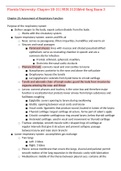
-
Florida University: Chapter 20-31| NUR 3125Med-Surg Exam 3,100% CORRECT
- Exam (elaborations) • 131 pages • 2023
-
- $15.99
- 1x sold
- + learn more
Florida University: Chapter 20-31| NUR 3125Med-Surg Exam 3 Chapter 20: Assessment of Respiratory Function Purpose of the respiratory system ● Deliver oxygen to the body, expels carbon dioxide from the body ○ Works with the circulatory system ● Upper respiratory system: warms and fills air ○ Nose: serves as passageway, filters impurities, humidifies and warms air ○ Sinuses and nasal passages ■ Paranasal sinuses: lines with mucosa and ciliated pseudostratified epithelium; s...
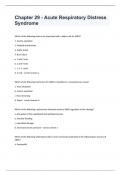
-
Chapter 29 - Acute Respiratory Distress Syndrome well answered 2024
- Exam (elaborations) • 8 pages • 2024
- Available in package deal
-
- $12.99
- + learn more
Chapter 29 - Acute Respiratory Distress SyndromeWhich of the following factors are associated with a higher risk for ARDS? 1. Gastric aspiration 2. Multiple transfusions 3. Septic shock 4. Burn injury a. 1 and 3 only b. 2 and 4 only c. 1, 2, 3, and 4 d. 3 only - correct answer a Which of the following risk factors for ARDS is classified as a nonpulmonary cause? a. Toxic inhalation b. Gastric aspiration c. Near drowning d. Sepsis - correct answer d Which of the following mechani...
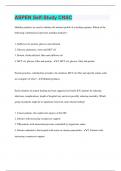
-
ASPEN Self-Study CNSC
- Exam (elaborations) • 455 pages • 2024
-
- $15.49
- + learn more
ASPEN Self-Study CNSC Modular products are used to enhance the nutrient profile of a feeding regimen. Which of the following combinations represents modular products? 1. Safflower oil, protein, glucose and selenium 2. Glucose, glutamine, water and MCT oil 3. Protein, cholecalciferol, fiber and safflower oil 4. MCT oil, glucose, fiber and protein - 4. MCT oil, glucose, fiber and protein Protein powders, carbohydrate powders, fat emulsion, MCT oil, fiber and specific amino acids are ...
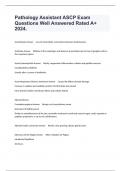
-
Pathology Assistant ASCP Exam Questions Well Answered Rated A+ 2024.
- Exam (elaborations) • 25 pages • 2024
-
Available in package deal
-
- $10.49
- + learn more
Acantholysis Answer Loss of intercellular connections between keratinocytes Achalasia Answer Dilation of the esophagus and absence of peristalsis due to loss of ganglion cells in the myenteric plexus Acute Pyelonephritis Answer Patchy, suppurative inflammation, tubular and papilliar necrosis Complicated by diabetes Usually after a course of antibiotics Acute Respiratory Distress Syndrome Answer Caused by diffuse alveolar damage Increase in capillary permeability, prot...
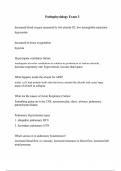
-
Pathophysiology Exam 3
- Exam (elaborations) • 33 pages • 2024
-
- $11.00
- + learn more
decreased blood oxygen measured by low arterial O2; low hemoglobin saturation hypoxemia decreased in tissue oxygenation hypoxia Hypercapnia ventilatory failure inadequate alveolar ventilation in relation to production of carbon dioxide, decrease respiratory rate, hypovolemia, increase dead space What happens inside the alveoli for ARD? water, cell, and protein leaks into the tissue around the alveoli and cause large areas of alveoli to collapse What are the causes of Acute Respiratory ...

-
ASPEN Self-Study CNSC QUESTIONS WITH PASSED ANSWERS!!
- Exam (elaborations) • 243 pages • 2024
- Available in package deal
-
- $7.99
- + learn more
Define ARDS. - ️️Acute respiratory distress syndrome - inflammatory response leading to diffuse alveolar damage and lung capillary endothelial injury. What is the evidence for use of omega-3 fatty acids in ARDS and ALI? - ️️Based on 3 level 1 studies the Guidelines for the Provision and Assessment of Nutrition Support Therapy in the Adult Critically Ill Patient in 2009 recommended patients with ARDS and severe ALI be placed on an enteral formulation characterized by an anti-inflamma...
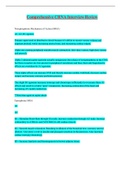
-
Comprehensive CRNA Interview Review Accurate responses are given.
- Presentation • 70 pages • 2023
-
- $18.99
- 3x sold
- + learn more
Comprehensive CRNA Interview Review Accurate responses are given. Comprehensive CRNA Interview Review Norepinephrine Mechanism of Action (MOA) A1, A2, B1 agonist. Primary agent used in distributive shock because it's ability to recruit venous volume and augment preload, while increasing arterial tone, and increasing cardiac output. Alpha one causing peripheral smooth muscle contraction. (low dose venous, high dose venous and arterial). Alpha 2 adrenoreceptor agonism actually ant...

-
Hemostasis and Hemodynamics MCQ questions with complete solutions
- Exam (elaborations) • 97 pages • 2023
-
- $13.99
- + learn more
A 60-year-old man with a history of multiple myocardial infarcts is hospitalized for shortness of breath. Physical examination reveals marked jugular distension, hepatomegaly, ascites, and pitting edema. A chest X-ray reveals cardiomegaly. The patient subsequently dies of cardiorespiratory failure. Examination of the lungs at autopsy would most likely disclose which of the following pathologic changes? (A) Diffuse alveolar damage with hyaline membranes (B) Intra-alveolar purulent exudate (C) ...

$6.50 for your textbook summary multiplied by 100 fellow students... Do the math: that's a lot of money! Don't be a thief of your own wallet and start uploading yours now. Discover all about earning on Stuvia


